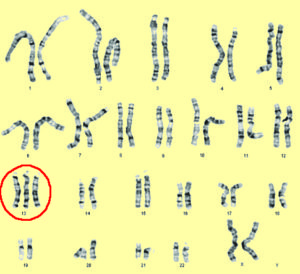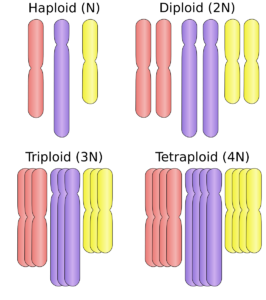87
Changes in numbers of genes
People have two copies of most genes, one copy inherited from each parent. In some cases, however, the number of copies varies—meaning that a person can be born with one, three, or more copies of particular genes. Less commonly, one or more genes may be entirely missing. This type of genetic difference is known as copy number variation (CNV).
Copy number variationresults from insertions, deletions, and duplications of large segments of DNA. These segments are big enough to include whole genes. Variation in gene copy number can influence the activity of genes and ultimately affect many body functions.
Researchers were surprised to learn that copy number variation accounts for a significant amount of genetic difference between people. More than 10 percent of human DNA appears to contain these differences in gene copy number. While much of this variation does not affect health or development, some differences likely influence a person’s risk of disease and response to certain drugs. Future research will focus on the consequences of copy number variation in different parts of the genome and study the contribution of these variations to many types of disease.
Changes in Numbers of Chromosomes
Human cells normally contain 23 pairs of chromosomes, for a total of 46 chromosomes in each cell. A change in the number of chromosomes can cause problems with growth, development, and function of the body’s systems. These changes can occur during the formation of reproductive cells (eggs and sperm), in early fetal development, or in any cell after birth. A gain or loss of chromosomes from the normal 46 is called aneuploidy.
A common form of aneuploidy is trisomy,or the presence of an extra chromosome in cells. “Tri-” is Greek for “three”; people with trisomy have three copies of a particular chromosome in cells instead of the normal two copies. Down syndrome is an example of a condition caused by trisomy. People with Down syndrome typically have three copies of chromosome 21 in each cell, for a total of 47 chromosomes per cell.

Monosomy,or the loss of one chromosome in cells, is another kind of aneuploidy. “Mono-” is Greek for “one”; people with monosomy have one copy of a particular chromosome in cells instead of the normal two copies. Turner syndrome is a condition caused by monosomy. Women with Turner syndrome usually have only one copy of the X chromosome in every cell, for a total of 45 chromosomes per cell.
Rarely, some cells end up with complete extra sets of chromosomes. Cells with one additional set of chromosomes, for a total of 69 chromosomes, are called triploid.Cells with two additional sets of chromosomes, for a total of 92 chromosomes, are called tetraploid. A condition in which every cell in the body has an extra set of chromosomes is not compatible with life.


In some cases, a change in the number of chromosomes occurs only in certain cells. When an individual has two or more cell populations with a different chromosomal makeup, this situation is called chromosomal mosaicism. Chromosomal mosaicism occurs from an error in cell division in cells other than eggs and sperm. Most commonly, some cells end up with one extra or missing chromosome (for a total of 45 or 47 chromosomes per cell), while other cells have the usual 46 chromosomes. Mosaic Turner syndrome is one example of chromosomal mosaicism. In females with this condition, some cells have 45 chromosomes because they are missing one copy of the X chromosome, while other cells have the usual number of chromosomes.
Many cancer cells also have changes in their number of chromosomes. These changes are not inherited; they occur in somatic cells (cells other than eggs or sperm) during the formation or progression of a cancerous tumor.
References
“Mutations and Health”by U.S. National Library of Medicineis in the Public Domain
